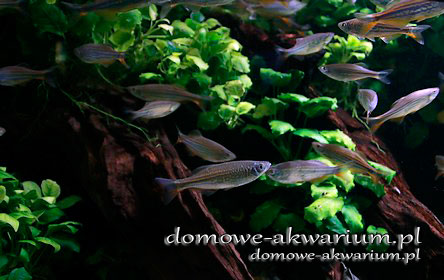
| Species | Malabar Danio |
|---|---|
| Other names | Malabaricus Devario |
| Latin Name | Devario Malabaricus |
| Family | cyprinids |
| Origin | Azja |
| Length | 8 cm |
| Temperature | 18 - 25°C |
| Water Hardness | soft - medium hard |
| pH | 6.5 - 8.0 |
| Aquarium Size | 80 L |
| Food | live, frozen, dry, plant |
Malabar Danio, Malabaricus Devario, India Giant Danio
This freshwater species naturally inhabits mountain streams, creeks and rivers with rocky-gravel substrates throughout the entire Indian Peninsula and in Sri Lanka. These waters are characterized by a high degree of oxygen saturation.
The Malabar danio is characterized by an emerald-blue body color with yellow-orange, interrupted, horizontal stripes on the sides. This species is often confused with Danio aequipinnatus. The key difference between them seems to be these stripes, which in the case of Danio aequipinnatus end at the base of the tail, while in Devario malabaricus they continue through the rays of the tail. The female is larger, less colorful, and thicker in the belly area compared to the male.
This is a calm, social and very active fish that is constantly on the move. It is also a schooling species that feels best in large groups - a minimum of 8 individuals. At that time, the fish is not stressed, and males color up significantly more. Males of this species have a tendency to establish hierarchies. For companions, select fish of similar sizes and temperaments: clowns, non-aggressive cichlids, armored catfish, and other species from the carp family.
The Malabar danio thrives in an aquarium that mimics a stream with moderate water flow, with substrate of varying granularity (from sand, through gravel to individual stones), some small roots or branches, plants. This species is sensitive to water quality - systematic partial water changes are essential. It is also necessary to cover the aquarium – the Malabar danio likes to jump.

This species is oviparous. Fish should be bred in a separate breeding aquarium, which should have dimmed lighting, plants with small and delicate leaves, or an egg grate. Water should be slightly acidic, well oxygenated, with a pH=7.0 and a temperature of 25-26°C. From a group of fish, select the fattest female and the most colorful male and transfer them to the spawning tank. Fish should spawn within 1-2 days - you can encourage this by feeding them with more live food or by changing more water. The female lays eggs in the water (even 200 bright orange eggs), and the eggs settle on the bottom or stick to the plants. After spawning, remove the parents immediately - they do not take care of their offspring and are happy to consume them. The larvae hatch after 1-1.5 days. The fry swim free in search of food 5 days later.